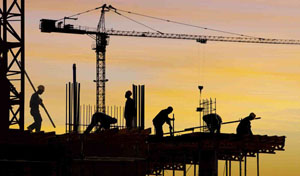-
Post-Tension
Before a post-tension slab is poured, high-strength steel strands or cables, called tendons, are laid in a tight grid. These help support and give strength to the slab once the concrete has been cured and they have been tensioned at the proper pressure.

Advantages of post-tensioned slab systems:
DSE slabs bring unique architectural freedom when compared to conventional building methods.
They allow increased spans to be achieved with thinner concrete sections. By reducing the need for columns the structure becomes more efficient and functional.
These advantages can result in significant savings in overall costs. There are also some situations where the height of the building is limited, in which the reduced story height has allowed additional floors to be constructed within the building envelope. The following figures 1 and 2 below show the deflection of the slab before the post-tension forces were applied. The finite element analysis is done using Ram Concept.Applications
The use of post-tensioned slab systems has been consistently growing in the recent years.
Typical applications have been:
- Private residential housing
- Offices
- Car parks
- Shopping centers
- Hospitals
- Hotels and apartments
- Industrial buildings
- Transverse pre-stressing of bridge deck slabs
-
Concrete
- Project management
- Building construction projects
- Construction planning
- Building renovation
- Stone work; construction of formwork and installation of reinforcement
- Regular and reinforced concrete structure installation (Footings, underground and over ground walls, pillars, Frames, beams, barrels, floor slabs, wall panels etc)
- Civil works
Major Equipments:
- Scaffoldings and props
- Wood, beams and plywood
- Slab formworks (several system)
- Tower Crane
- RMD formworks (vertical elements)
- Steel circular columns
- Bending machines
- Vibrators


